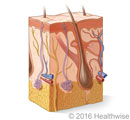Zits on Back Take a Long Time to Heal Hurt Sting
Folliculitis
Topic Overview

What is folliculitis?
Folliculitis is an inflammation of the hair follicles. Each hair on your body grows out of a tiny pouch called a follicle. You can have folliculitis on any part of your body that has hair. But it is most common on the beard area, arms, back, buttocks, and legs.
What causes folliculitis?
It may be caused by bacteria. It also can be caused by yeast or another type of fungus.
You may get folliculitis if you have damaged hair follicles. Shaving or wearing clothes that rub the skin can irritate the follicles, which can lead to folliculitis. They also can become blocked or irritated by sweat, machine oils, or makeup. When the follicles are injured, they are more likely to become infected.
You are more likely to get folliculitis if you:
- Use a hot tub, whirlpool, or swimming pool that is not properly treated with chlorine.
- Wear tight clothes.
- Use or work with substances that can irritate or block the follicles. Examples include makeup, cocoa butter, motor oil, tar, and creosote.
- Have an infected cut, scrape, or surgical wound. The bacteria or fungi can spread to nearby hair follicles.
- Have a disease such as diabetes or HIV that lowers your ability to fight infection.
What are the symptoms?
Folliculitis usually looks like red pimples with a hair in the center of each one. The pimples may have pus in them, and they may itch or burn. When the pimples break open, they may drain pus, blood, or both.
"Hot tub folliculitis" most often appears about 72 hours after you've been in a hot tub or spa. Many small pimples appear on your stomach and sometimes on your arms and legs. You might have a mild fever and have an upset stomach. Most of the time, this kind of folliculitis goes away on its own in 7 to 10 days.
How is folliculitis diagnosed?
Your doctor will check your skin and ask about your health and activities. He or she may do tests to find out what is causing your folliculitis and to make sure you don't have a different problem, such as impetigo or heat rash. Testing a sample of the fluid in the pimples or a sample of tissue can help your doctor learn what is causing the infection.
How is it treated?
Mild folliculitis usually heals on its own in about 2 weeks. You can take care of yourself at home with:
- A warm compress. This may ease itching and help healing. To make a warm compress, soak a hand towel in warm water. Wring out the excess water, and place the towel on the affected skin.
- Medicated shampoo. It can be used to treat folliculitis on the scalp or beard.
If the inflammation gets worse or doesn't go away, you may need to see your doctor. He or she may prescribe medicine, such as an antibiotic.
Call your doctor if you have folliculitis and:
- It spreads or keeps coming back.
- You have a fever over 101°F (38°C).
- The affected area becomes red, swollen, warm, or more painful.
If the inflammation doesn't go away or keeps coming back, laser hair removal may be an option. Laser treatment destroys the hair follicles, so they can't get inflamed.
How can you prevent folliculitis?
There are many things you can do to prevent folliculitis or keep it from spreading.
- Bathe or shower daily with a mild soap. Also, bathe or shower after you exercise and after you work around chemicals.
- Avoid sharing towels, washcloths, or other personal items. If you have folliculitis, use a clean washcloth and towel each time you bathe.
- Don't scratch the bumps.
- Avoid shaving the bumps. If you must shave, change the razor blade each time.
- Avoid using oils on your skin. Oils can trap bacteria in the pores of your skin and can cause folliculitis.
- After you use public hot tubs or spas, shower right away with soap. If you own your own hot tub, follow the manufacturer's instructions for keeping it clean.
References
Other Works Consulted
- Berger TG (2012). Dermatologic disorders. In SJ McPhee, MA Papadakis, eds., 2012 Current Medical Diagnosis and Treatment, 51st ed., pp. 93–163. New York: McGraw-Hill.
- Habif TP (2010). Bacterial infections. In Clinical Dermatology, A Color Guide to Diagnosis and Therapy, 5th ed., pp. 335–381. Edinburgh: Mosby Elsevier.
- Hall JC (2010). Dermatologic bacteriology. In JC Hall, ed., Sauer's Manual of Skin Diseases, 10th ed., pp. 202–219. Philadelphia: Lippincott Williams and Wilkins.
- Korman NJ (2016). Macular, papular, vesiculobullous, and pustular diseases. In L Goldman, A Schafer, eds., Goldman-Cecil Medicine, 25th ed., vol. 2, pp. 2671–2682. Philadelphia: Saunders.
- Pasternack MS, Morton NS (2015). Cellulitis, necrotizing fasciitis, and subcutaneous tissue infections. In JE Bennett et al., eds., Mandell, Douglas, and Bennett's Principles and Practice of Infectious Diseases, 8th ed., vol. 1, pp. 1194–1214. Philadelphia: Saunders.
Credits
Current as of: July 2, 2020
Author: Healthwise Staff
Medical Review:
Kathleen Romito MD - Family Medicine
Adam Husney MD - Family Medicine
E. Gregory Thompson MD - Internal Medicine
Martin J. Gabica MD - Family Medicine
Amy McMichael MD - Dermatology
Zits on Back Take a Long Time to Heal Hurt Sting
Source: https://www.uofmhealth.org/health-library/hw171614
0 Response to "Zits on Back Take a Long Time to Heal Hurt Sting"
Post a Comment